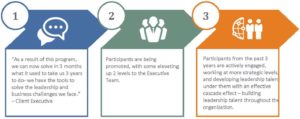At Right Management, Great Lakes, we are privileged to work with veteran leaders, emerging leaders, and all levels of collaborators, as we pursue our overriding mission – to ensure that clients maximize the talents of their most precious asset: people.
A universal observation the Right Great Lakes team has made, over four successful decades, is that the most important characteristic of successful organizations is an environment based on fluid, transparent, productive communication. The best communication comes from leaders, and evolving leaders, who master two main skills:
- They ask good questions to elicit effective conversation and conclusions among team members, AND
- They truly HEAR the answers to those questions, and (perhaps more importantly) the answers to questions they may have forgotten to ask!
Top leaders need to ensure that two-way communication is embedded in organizational culture. Communication should be regular and implemented through all channels — online internal sites, dashboards, company networks, newsletters, town-hall meetings, team meetings, emails, and frequent two-way in-person conversations. A healthy, growing organization can never communicate, too much. In that communicative culture, truth and transparency are paramount. Team members don’t expect all news to be positive. Sharing as much as possible, in a timely fashion, engenders trust and a feeling of mutual respect. Before news is communicated externally (to the press, to partners, to customers and stakeholders), team members should hear their workplace news, first. And, above all, there should be a communications plan, agreed to by leadership, and implemented by the company’s skilled communications staff.
Everyday team leaders are the heart of communications. To master effective communication, excellent “listening skills” is essential for team leaders, and the organization. At Right Management, we have boiled the ability to truly listen down to very practical techniques:
- Focus on simplicity. Keep your questions, emails and conversation, focused, short, and to-the-point, when possible.
- Ensure that the people you are interacting with know that you are fully present in any conversation. Don’t anticipate what they will say. Maintain eye contact. Don’t allow yourself to be distracted.
- Truly listen to the answers to questions you pose to your teams. Then paraphrase the answers you hear to check that you have comprehended correctly.
- Don’t necessarily have a pre-planned agenda for every conversation, and every meeting. Sometimes the most enlightening conversations and meetings are filled with spontaneity. Don’t assume you have already heard the answers – you haven’t!
- Don’t immediately respond to what you hear and don’t argue with answers to questions you pose. One of the best rules for innovative brainstorming is “there are no incorrect answers.” If you adopt that as the rule in most conversations, you may be positively surprised by how enlightened the interchange will become!
- Make the atmosphere as safe as possible for the person or people involved in any meeting or conversation. Create a culture where vulnerability is prized and valued. If a person knows they can trust you, and there will be ensured confidentiality around a subject that they want to stay confidential, they can be far more candid. And you will learn, and grow, more from the exchange.
- Don’t interrupt. This is hard if you are engaged in a spirited conversation, and it requires patience. But you will find that by limiting interruption, you will save time in the long run. If you don’t understand something, wait until the speaker is done, and ask for clarification.
- Ask follow-up questions when you can. This strengthens your engagement with a speaker and a team.
- Listen, more than you speak. Be as quiet as you can be after posing a question.
- Show you are listening. You can do this through body language, eye contact, facial expressions, nodding, or leaning in. Don’t speak. Show your engagement.
- Listen to learn. Go into every conversation convinced that there will be something from it that will add information or a new insight. Remain interested and invested in the conversation for your own education!
- Empathize with the speaker when you can. Let him/her know that you are just as interested in the subject matter as he/she is, because you are consistently curious, and excited about unique ideas and opinions.
- Then, when it is appropriate, don’t be shy about summarizing what you have heard. Do it so that you can ensure you heard correctly and so that you remember the essence of the meeting, the conversation, the presentation.
Finally, consider mastering “360-degree listening.” This is an art. But it is where the magic of communication often occurs. When you practice this, you are hearing both what a person is saying, and potentially what they are NOT saying, what they may be omitting for good reasons or because it is inessential to them. 360-degree listening, and communication, happens when you move from the details of a conversation to a 10,000-foot vantage point, and back again. It helps you, and the team, create space for invention, innovation, progress. It demands that you are present and listening, but it also necessitates that you can move, agilely, to ingest what you have heard, get inspired by it, and help your team make decisions based on the learning. When that begins to occur, you will find that you can move mountains together – and progress is assured.
Above all, listen well. It is key to transformation, growth, and success.
RIGHT MANAGEMENT GREAT LAKES can help.
Great leaders make great teams, and great organizations. We can help your high potential first-line supervisors evolve into the great leaders you need. Check out our POWERLEAD program, through which we supply skills that help mold great leaders of the future.
We help you create everyday leaders. Every day.






